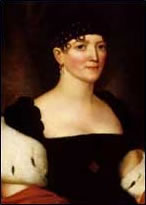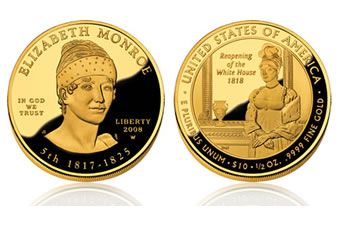Elizabeth Monroe First Spouse Gold Coins
Elizabeth Monroe First Spouse Gold Coins were the fifth commemoratives issued in the series of coins to honor American First Ladies. The United States Mint released the $10 coins on February 8, 2008.
Struck in one-half ounce 24-karat gold, the proof version was initially listed for $619.95 and the uncirculated version at $599.95. The Mint has since changed its pricing policy and updates gold coin prices based on a weekly performance of gold. (See First Spouse Coin Price Guide for latest Mint prices and sales figures.)
The obverse (heads side) of the Elizabeth Monroe First Spouse Coin shows a beautiful portrait of Elizabeth designed by Susan Gamble and sculpted by Don Everhart. The reverse (tails side) depicts Elizabeth at a reception opening the White House after it had been burned in the War of 1812. It was designed by Donna Weaver and sculpted by Charles Vickers.
(See large Elizabeth Monroe First Spouse Coin images.)
Elizabeth Monroe Biography (1768-1830)
 In a drastic departure from the accessible White House of James Madison (previous President of the United States), Elizabeth Monroe would bring not only formality to ceremonial functions, but restricted access to the first family in general. This would, in the end, prove to be a detriment to the political success of her husband.
In a drastic departure from the accessible White House of James Madison (previous President of the United States), Elizabeth Monroe would bring not only formality to ceremonial functions, but restricted access to the first family in general. This would, in the end, prove to be a detriment to the political success of her husband.
Lawrence and Hannah Kortright welcomed their daughter into the world on June 30, 1768. Lawrence was a wealthy businessman, but little is known about Elizabeth’s childhood. It is likely she was formally educated in some manner, as experiences in later life showed her to be comfortable with some foreign languages and the social skills of a society woman.
On February 16, 1786, Elizabeth married James Monroe, former Lieutenant Colonel during the Revolution. At the time of their marriage he was serving as a U.S. Congressman from Virginia. Political ambition kept the Monroes on the move. James held several offices including Governor of Virginia, United States Senator, and United States Diplomatic Minister to several countries including England and France. During their tenure in France, Elizabeth made such a positive impression that the French dubbed her "la belle Americaine" (the beautiful American).
It was at this time that Elizabeth undertook a valiant mission near the end of the French Revolution when she took it upon herself to visit the imprisoned Adrienne de Noiolles de Lafayette, wife of the Marquis de Lafayette. Marquis de Lafayette had fled the country but his wife was expected to die by the guillotine. Elizabeth’s brave visit to the prison showed the French the un-official, but tangible, desire of the United States that Madame Lafayette not be executed. This gave them the excuse they needed to release their prisoner while not admitting any wrongdoing.
Elected to the Presidency in 1817, the Monroes quickly reversed the informal atmosphere of the White House made famous by the previous Madison administration. They instituted more formal ceremonies and limited access to the first family to a select few. This gave them an air of aloofness to those in Washington D.C. society. The remoteness was reinforced even more when their daughter was married in the White House, and only a small group of friends and family were invited (it was custom at the time in D.C. to have large open weddings).
In the White House, Elizabeth’s health continued to deteriorate, forcing the Monroes to guard her time even more closely. Not divulged at the time, current scholars tend to believe she was suffering from epilepsy. Had officials released this information to the public then, it might have gone a long way to explaining the detachment everyone felt to their leader and his family.
After serving two terms, the Monroes left Washington to live at their home in Virginia. Elizabeth’s health problems persisted, and she finally passed away in 1830. Family tradition tells that James burned all of their personal correspondence, leaving many questions unanswered to history.
Additional Resources
- Elizabeth Monroe First Spouse Coin images
- Elizabeth Monroe First Spouse Medal images
- Elizabeth Monroe First Spouse Coin Designs
- US Mint press announcement
- US Mint First Spouse Program
- White House Biography of Elizabeth Monroe
- Monroe First Spouse Coins on Sale

